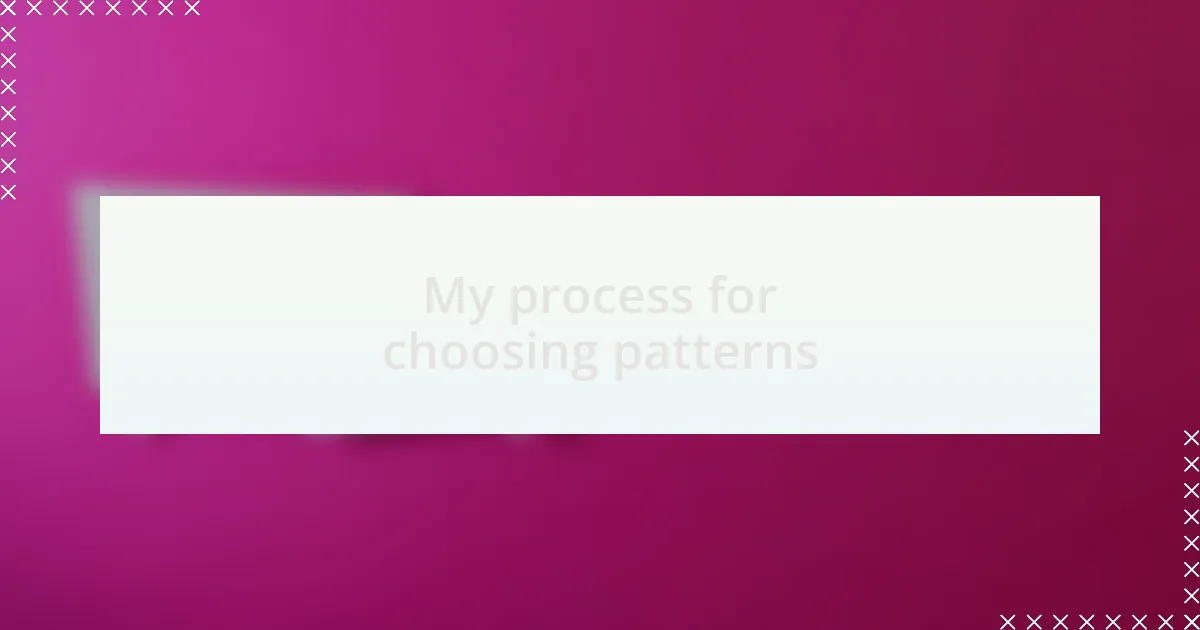Key takeaways:
- Pattern selection should align with project goals, user emotions, and the overall design narrative.
- User testing and feedback are crucial for discovering effective design patterns that resonate with the audience.
- Understanding the target audience’s preferences significantly influences the effectiveness of design choices.
- Different types of patterns (geometric, organic, abstract) serve unique purposes and enhance user engagement in various design contexts.
Author: Oliver Bancroft
Bio: Oliver Bancroft is an accomplished author and storyteller known for his vivid narratives and intricate character development. With a background in literature and creative writing, Oliver’s work often explores themes of human resilience and the complexities of modern life. His debut novel, “Whispers of the Forgotten,” received critical acclaim and was nominated for several literary awards. In addition to his fiction, Oliver contributes essays and articles to various literary magazines. When he’s not writing, he enjoys hiking and exploring the great outdoors with his dog, Max. Oliver resides in Portland, Oregon.
Understanding pattern selection process
When diving into the pattern selection process, I always start by identifying the primary goals of the project. I ask myself, “What emotion do I want the users to feel?” This reflection helps me to align the chosen patterns with the desired user experience. For instance, during a recent project, I opted for soft, flowing patterns to evoke a sense of calm, transforming a potentially overwhelming interface into a soothing haven.
I also believe in the importance of context. Each pattern tells a story, and it’s vital to consider how it fits within the broader design narrative. Once, I experimented with a bold geometric pattern that seemed vibrant and lively, but it clashed with the overall aesthetic of the website, causing confusion rather than excitement. This taught me to ensure that every pattern not only stands out but also enhances the site’s story.
Finally, I can’t stress enough the value of testing and feedback. Engaging users in the selection process can yield unexpected insights. I recall a time when I gathered a group to test different pattern variations, leading to a surprising revelation: users connected deeply with a more subtle, textured background rather than the flashy options I initially preferred. This experience reinforced my belief that the best designs emerge from collaboration and openness to user perspective.
Factors influencing pattern choices
When it comes to choosing patterns, visual hierarchy plays a crucial role. I often find myself pondering, “How will users navigate through my design?” The patterns I select should naturally guide the viewer’s eye, creating a seamless flow of information. For example, during a project where I designed a wellness app, I chose softer background patterns to gently lead users toward important buttons, ensuring each interaction felt intuitive and effortless.
Another significant factor is the target audience’s preferences. With every project, I take time to research who will be using the design. I recall working on a youth-oriented platform and realizing that bold, vibrant patterns resonated more with the demographic than muted tones. This insight taught me that understanding the audience’s tastes can significantly alter the effectiveness of the design, ensuring it feels relatable and engaging.
Then there’s the matter of consistency. I frequently ask myself, “Does this pattern align with the overall brand identity?” For instance, in a branding overhaul for a local bakery, I selected whimsical, hand-drawn patterns that echoed the artisanal quality of their baked goods. This choice not only reinforced the brand’s charm but also created a cohesive visual experience that drew customers back time and again. Emphasizing brand alignment leads to a stronger emotional connection with users.
Types of patterns in design
When exploring types of patterns in design, I often categorize them into geometric, organic, and abstract. Geometric patterns deliver a sense of order and precision, and I remember incorporating them into a tech-focused project. The sharp lines and angles enhanced the modern feel, making users perceive the product as cutting-edge and reliable. How do you think geometric shapes influence our perception of technology?
Organic patterns, on the other hand, take a more fluid approach. I experimented with freeform shapes while working on an art studio website. The undulating lines and curves created a warm, inviting atmosphere that perfectly reflected the creativity of the artists involved. There’s something inherently comforting about these patterns, as they evoke nature and human touch, which is what I strive to capture in my work.
Abstract patterns can be fascinating as they challenge the viewer’s interpretation. I vividly recall designing a marketing campaign using them, deliberately sparking intrigue and curiosity. The beauty of abstract design lies in its ability to communicate emotion without explicit representation. I often think, “What story do these shapes tell to my audience?” Ultimately, each type of pattern serves a unique purpose, enriching the overall user experience and engaging them on multiple levels.
Examples of favorite patterns
When it comes to my favorite patterns, I find myself drawn to chevrons. I first used them in a branding project for a local café, and the effect was striking. The zig-zag design added a playful yet sophisticated touch, perfectly aligning with the café’s vibrant energy. Can you imagine how dynamic such a pattern can feel when it’s layered with bright colors?
Another pattern that resonates with me is the herringbone. I integrated this design into a user interface for a fashion website, allowing the texture to convey elegance and depth. The interlocking shapes not only added character but also guided users’ eyes effortlessly through the content. Every time I see herringbone, I can’t help but wonder how a classic pattern can still feel so fresh and modern.
Lastly, I absolutely love incorporating polka dots into my designs. I remember using them for a children’s educational app, where their cheerful randomness brought a sense of fun and excitement. The dots created a whimsical atmosphere, encouraging engagement and exploration. Have you ever noticed how such a simple pattern can evoke so much joy in our designs?

Leave a Reply